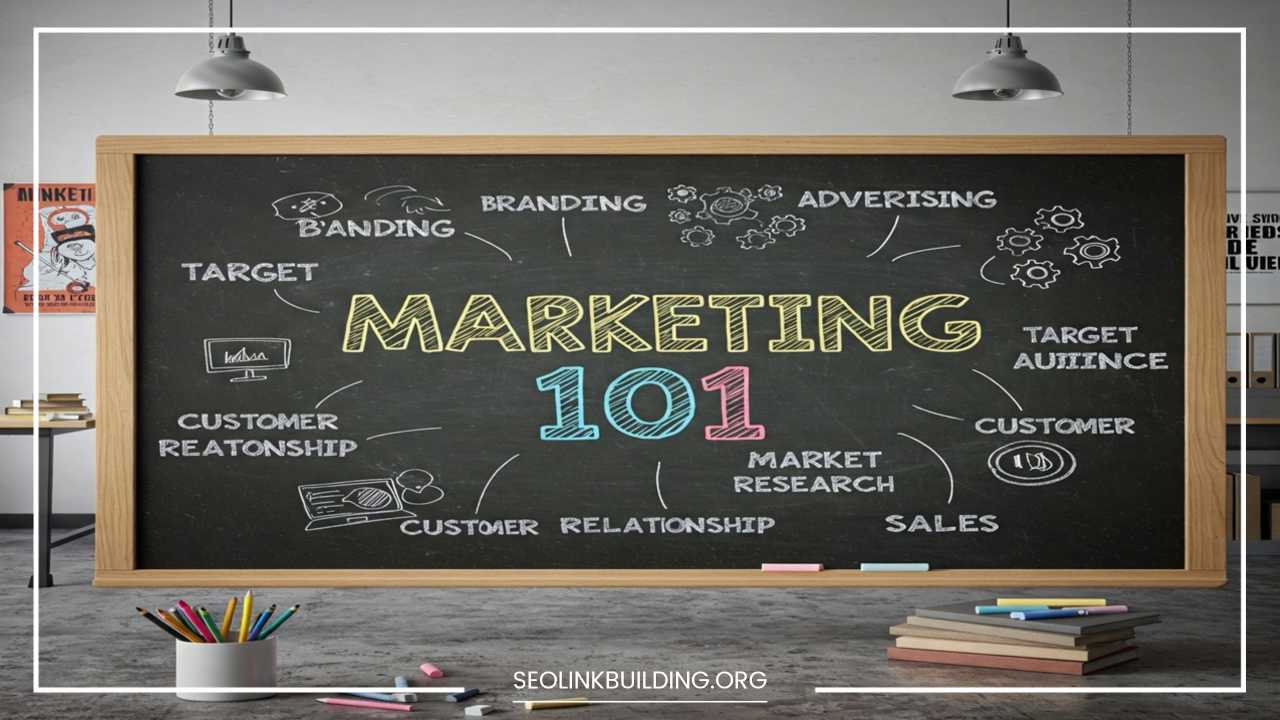Marketing 101: Marketing Basics in Simple Words

Marketing 101
Marketing 101: Marketing Basics in Simple Words
Marketing. The word often conjures images of flashy advertisements, persuasive salespeople, and endless social media campaigns. While these are certainly aspects of marketing, the core of it is far simpler and more fundamental.
At its heart, marketing is about understanding people – their needs, their wants, and how your product or service can fulfill them.
This article will break down the essential basics of marketing in plain and simple language, providing a solid foundation for anyone looking to understand this vital aspect of business.
What Exactly is Marketing? It’s More Than Just Selling
Many people mistakenly believe that marketing is synonymous with selling. While selling is undoubtedly a part of marketing, it’s just one piece of a much larger puzzle.
Think of it this way: selling is about getting rid of what you have, while marketing is about having what people want in the first place.
A simple and effective definition of marketing is the process of understanding your customers, creating value for them, and building strong relationships that benefit both the customer and your organization.
Let’s break this down:
- Understanding your customers: This is the crucial first step. It involves figuring out who your potential customers are, what they need, what problems they face, and what they desire. This requires research, observation, and empathy.
- Creating value for them: Once you understand your customers, you need to develop a product or service that meets their needs or solves their problems. This “value” can be tangible (like a useful product) or intangible (like a helpful service or a positive experience).
- Building strong relationships: Marketing isn’t a one-time transaction. It’s about fostering long-term connections with your customers. This involves providing excellent customer service, communicating effectively, and building trust and loyalty.
- Benefiting both the customer and your organization: Successful marketing creates a win-win situation. Customers get what they need or want, and your organization achieves its goals (which could be profit, growth, or simply making a positive impact).
So, marketing is not just about pushing products onto people. It’s about a continuous cycle of understanding, creating, and connecting.
The Marketing Process: A Step-by-Step Guide
While the definition of marketing is straightforward, the process of actually doing it effectively involves several key steps. Here’s a simplified overview:
- Understand the Market and Customer Needs: This is the foundation of all marketing efforts. It involves conducting market research to identify trends, understand the competitive landscape, and gain deep insights into your potential customers. This includes:
- Identifying your target audience: Who are the specific people you want to reach? What are their demographics (age, location, income, education)? What are their psychographics (interests, values, lifestyle)?
- Analyzing their needs and wants: What problems are they trying to solve? What desires do they have? What motivates their purchasing decisions?
- Studying the competition: What are other businesses in your industry doing? What are their strengths and weaknesses? How can you differentiate yourself?
- Develop a Customer-Driven Marketing Strategy: Based on your understanding of the market and your target audience, you need to develop a strategy that outlines how you will create value for them and build profitable relationships. This involves:
- Segmentation: Dividing the overall market into smaller groups (segments) of customers with similar needs and characteristics.
- Targeting: Selecting the specific segment(s) you will focus your marketing efforts on.
- Differentiation: Setting your product or service apart from the competition by highlighting its unique benefits and value proposition.
- Positioning: Creating a clear and desirable image of your product or service in the minds of your target customers.
- Construct an Integrated Marketing Program (The Marketing Mix): This involves putting your marketing strategy into action by developing a plan that utilizes various marketing tools and tactics. The most well-known framework for this is the Marketing Mix, often referred to as the 4 Ps:
- Product: This refers to the goods or services you offer to your target market. It includes features, quality, design, branding, packaging, and any associated services. The key question here is: What are you offering that meets the needs of your customers?
- Price: This is the amount of money customers are willing to pay for your product or service. Pricing decisions need to consider costs, competition, perceived value, and the overall marketing strategy. The key question is: What is the right price that is both profitable for you and acceptable to your customers?
- Place (Distribution): This refers to how you make your product or service available to your target customers. It includes distribution channels, logistics, inventory management, and retail locations (if applicable). The key question is: Where and how will your customers be able to access your offering?
- Promotion: This encompasses all the activities you undertake to communicate the value of your product or service to your target audience and persuade them to buy. This includes advertising, public relations, sales promotions, personal selling, and increasingly, digital marketing. The key question is: How will you inform and persuade your customers about your product or service?
While the 4 Ps remain a fundamental framework, modern marketing often expands on this to include additional elements, particularly in the service industry. Some common additions include:
- People: This refers to the employees who interact with your customers. Their skills, training, and attitude significantly impact the customer experience.
- Process: This refers to the systems and procedures involved in delivering your product or service. Efficient and customer-friendly processes are crucial for satisfaction.
- Physical Evidence: This refers to the tangible aspects of your service that customers can see, such as the environment, website, brochures, and staff appearance.
Another way to think about the marketing mix is through the lens of the 4 Cs:
- Customer Solution: Focuses on meeting the customer’s needs and solving their problems (aligns with Product).
- Customer Cost: Considers the total cost to the customer, including price, time, and effort (aligns with Price).
- Convenience: Emphasizes making it easy for the customer to access the product or service (aligns with Place).
- Communication: Highlights the importance of two-way dialogue and building relationships with customers (aligns with Promotion).
Regardless of the framework you use, the goal is to create a cohesive and integrated marketing program that effectively reaches your target audience and delivers value.
- Build Profitable Customer Relationships: This is about nurturing the connections you make with your customers and fostering loyalty. This involves:
- Delivering excellent customer service: Going above and beyond to meet customer expectations.
- Communicating effectively: Keeping customers informed and engaged.
- Building trust and rapport: Creating a positive and personal connection.
- Implementing customer relationship management (CRM) systems: Utilizing technology to manage and analyze customer interactions and data.
- Capture Value from Customers to Create Profits and Customer Equity: The ultimate goal of marketing is to create value for the organization as well. This involves:
- Increasing sales and revenue.
- Improving customer loyalty and retention.
- Building strong brand equity (the value of your brand).
- Ultimately, achieving profitability and sustainable growth.
Understanding Your Audience: The Key to Success
As mentioned earlier, understanding your target audience is paramount to effective marketing. You can’t effectively market to everyone. Trying to do so will likely result in wasted resources and a diluted message.
Here’s why understanding your audience is so crucial:
- Tailoring your message: Knowing who you’re talking to allows you to craft messages that resonate with their specific needs, interests, and pain points.
- Choosing the right channels: Different audiences frequent different platforms and consume information in different ways. Understanding your audience helps you choose the most effective channels to reach them (e.g., social media, email, traditional advertising).
- Developing the right products and services: Understanding your audience’s needs and desires helps you develop products and services that truly meet their requirements.
- Setting the right price: Knowing your audience’s budget and perceived value helps you determine an appropriate price point.
- Building stronger relationships: When you understand your audience, you can communicate with them on a more personal level, fostering trust and loyalty.
To truly understand your audience, you need to go beyond basic demographics. Consider these factors:
- Demographics: Age, gender, location, income, education, occupation, family size, etc.
- Psychographics: Interests, hobbies, values, attitudes, lifestyle, personality, opinions, etc.
- Behavioral: Purchase history, brand loyalty, usage rate, benefits sought, etc.
- Needs and Pain Points: What problems are they trying to solve? What are their frustrations? What are their unmet needs?
Gathering this information can involve various methods, such as:
- Market research surveys: Asking direct questions to your target audience.
- Focus groups: Gathering small groups of people to discuss their opinions and experiences.
- Analyzing customer data: Examining past purchase behavior and interactions.
- Social media listening: Monitoring online conversations and mentions related to your brand and industry.
- Competitor analysis: Understanding who your competitors are targeting and how.
- Creating buyer personas: Developing fictional representations of your ideal customers based on your research.
By investing time and effort in understanding your audience, you’ll be able to create more effective marketing campaigns and build stronger, more profitable relationships.
Creating Value: What Makes Your Offering Special?
In today’s competitive marketplace, simply having a product or service isn’t enough. You need to offer something that provides genuine value to your customers. This is where the concept of a value proposition comes in.
A value proposition is a clear and concise statement that explains the benefit your product or service provides to your target customer, how it solves their problem or fulfills their need, and what makes you different from your competitors.
A strong value proposition should answer the following questions from the customer’s perspective:
- What’s in it for me? (The benefit)
- Why should I choose you over the competition? (The differentiation)
Here are some key elements of a compelling value proposition:
- Clarity: It should be easy to understand and communicate.
- Specificity: It should clearly identify the target customer and the specific benefits offered.
- Uniqueness: It should highlight what makes your offering different and better than the alternatives.
- Desirability: It should address a real need or want of the target customer.
- Credibility: It should be believable and supported by evidence.
Developing a strong value proposition requires a deep understanding of your target audience and your competitive landscape. You need to identify their pain points and demonstrate how your offering provides a superior solution.
Branding: Building Recognition and Trust
Branding is another crucial aspect of marketing. Your brand is more than just your logo or your company name. It’s the overall perception that customers have of your business. It encompasses everything from your visual identity to your customer service to your reputation.
Effective branding helps you:
- Stand out from the competition: In a crowded marketplace, a strong brand helps you differentiate yourself and capture attention.
- Build trust and credibility: A consistent and positive brand image fosters trust and makes customers more likely to choose you.
- Create customer loyalty: When customers connect with your brand on an emotional level, they are more likely to become repeat customers and brand advocates.
- Command a premium price: Strong brands often have the ability to charge more for their products or services because customers perceive them as being of higher value.
- Attract and retain talent: A strong brand can also make your company a more attractive place to work.
Key elements of building a strong brand include:
- Brand Identity: This includes your logo, color palette, typography, and overall visual style. It should be consistent across all your marketing materials.
- Brand Messaging: This is the language you use to communicate your brand values, personality, and unique selling proposition. It should be consistent and resonate with your target audience.
- Brand Values: These are the core principles that guide your business and define what you stand for.
- Brand Personality: This is the human-like characteristics you associate with your brand (e.g., friendly, sophisticated, innovative).
- Customer Experience: Every interaction a customer has with your brand contributes to their overall perception. Providing a positive and consistent experience is crucial for building a strong brand.
Building a strong brand takes time and effort. It requires consistency, authenticity, and a deep understanding of your target audience.
Beyond the Basics: Modern Marketing Trends
While the fundamental principles of marketing remain the same, the landscape of marketing is constantly evolving. Here are a few key modern trends to be aware of:
- Digital Marketing: The rise of the internet and digital technologies has transformed marketing. Digital marketing encompasses a wide range of online activities, including search engine optimization (SEO), search engine marketing (SEM), social media marketing, email marketing, content marketing, and influencer marketing.
- Content Marketing: Creating and distributing valuable, relevant, and consistent content to attract and retain a clearly defined audience. This can include blog posts, articles, videos, infographics, and more.
- Social Media Marketing: Utilizing social media platforms to connect with your audience, build brand awareness, drive traffic, and generate leads.
- Personalization: Tailoring marketing messages and experiences to individual customers based on their data and preferences.
- Data-Driven Marketing: Using data and analytics to understand customer behavior, measure marketing effectiveness, and make informed decisions.
- Customer Experience Management (CXM): Focusing on creating positive and seamless experiences for customers across all touchpoints.
Understanding these modern trends is essential for staying competitive in today’s dynamic marketplace.
Final Thoughts: Marketing is a Continuous Journey
Marketing is not a one-time task or a set of isolated activities. It’s an ongoing process of understanding your customers, creating value for them, and building lasting relationships.
By grasping the fundamental concepts outlined in this article – from understanding your audience to crafting a compelling value proposition and building a strong brand – you’ll have a solid foundation for navigating the world of marketing.
Remember that the key to success lies in putting the customer at the center of everything you do and continuously adapting to their evolving needs and the changing market landscape.
Marketing is a continuous journey of learning, adapting, and innovating to create mutually beneficial relationships between your organization and your customers.













